In this article, I’ll share a simple, effective method for how to crossbreed peppers properly. With enough time and space, you can cross two pepper varieties to create a brand new type of pepper.
Intentional plant breeding dates back to the early days of agriculture. Early efforts used the ‘selective breeding’ method. Essentially, people were growing starch grains every year, selecting the best quality plants to use for the next year’s crop.
Today, plant breeding is responsible for almost any fresh produce you can buy at the grocery store. From huge, oversized apples to super-sweet grape tomatoes, crossbreeding was certainly a part of their creation.
Peppers have made major strides through crossbreeding methods. Some examples include the super-spicy 7 Pot Primo and the non-spicy habanada pepper. These, and many others, have come from careful cross-pollination methods and a whole lot of patience.
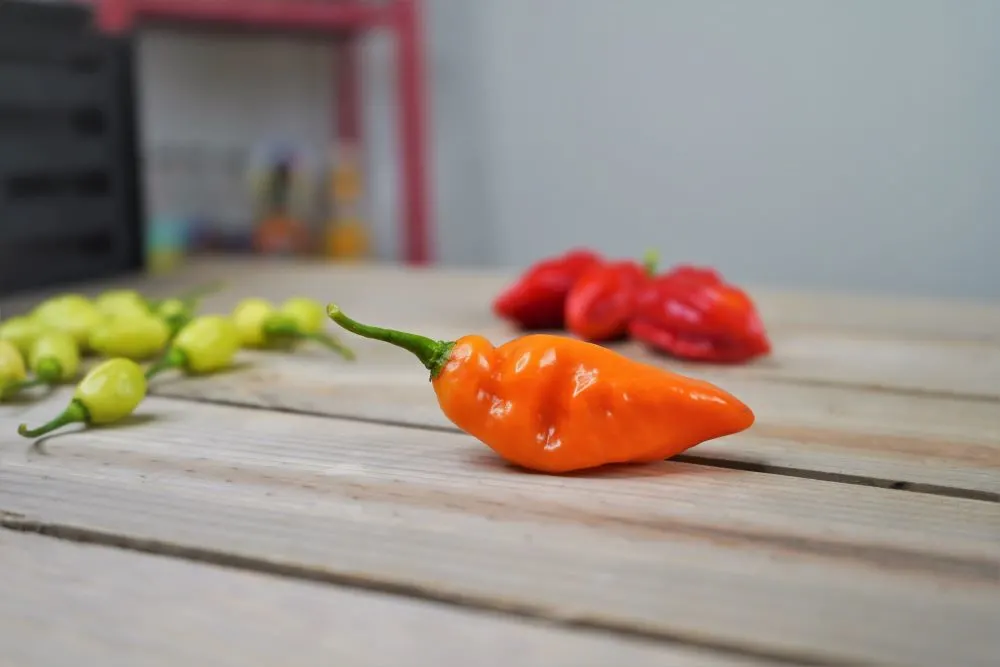
Hopefully this doesn’t scare you, because after all, crossbreeding occurs in nature. Humans simply observed and learned how plants have evolved to work over their millions of years on the planet.
So, today I’m going to share the basic method for crossbreeding peppers the right way. Although it is relatively simple, it takes a lot of time, dedication, and patience to be successful.
Let’s get started!
Quick-Start One-Pager:
Before getting into the fine details, let’s start with the overall process in a visual form. This quick-guide illustrates how to crossbreed peppers from start to finish. Keep in mind, these steps represent many months and years of dedicated work.
I will go through each of the major steps and terms in more detail. However, this printable graphic can be a valuable resource to come back to throughout the process.
Why Crossbreed Peppers?
First, I want to talk about why crossbreeding peppers might be appealing. Each breeder typically has a different goal in mind, while others just want to experiment and expand their hobby of growing peppers.
For example, some breeders are obsessed with creating the hottest pepper possible. Others want to create a pepper that combines the shape and color of two pepper varieties. Or, you may be most interested in achieving a delicious flavor.
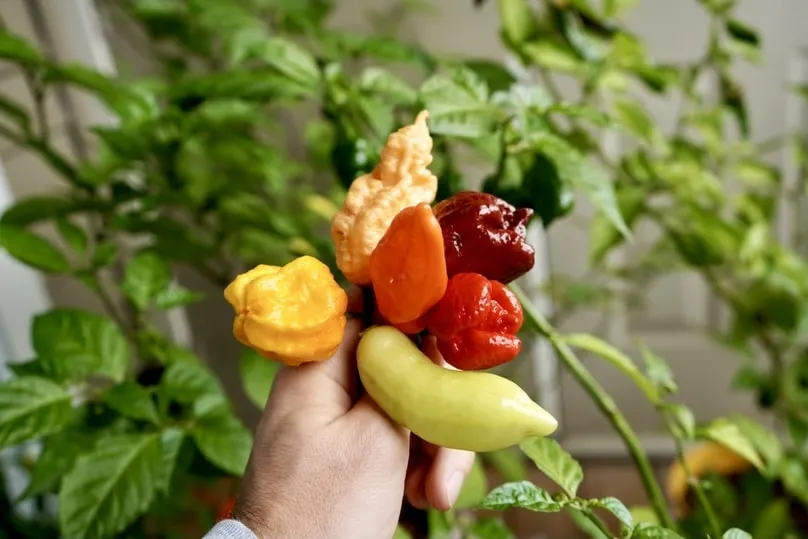
All of these traits are coded into the genetics of each pepper plant. By inter-breeding stable pepper varieties, the genetics become shared, resulting in a new plant type.
Other characteristics that are determined by genetics are plant productivity, time to harvest, disease resistance, foliage color or variegation, and much, much more.
Whatever your goal is, it is pretty obvious why crossbreeding peppers is interesting. I can make my own pepper variety?! How exciting is that?
The only drawback? It takes a very long time.
Flower Anatomy and Terminology
Before getting started, you should have a good understanding of the basic anatomy of pepper flowers. By cross breeding peppers, we are essentially intervening with the natural reproductive process of the plants.
Thankfully, the only portion of the plant we need to understand are the flowers. This is where the magic happens to produce the seed-bearing fruits.
A single pepper flower contains both male and female reproductive organs, allowing for self-pollination.
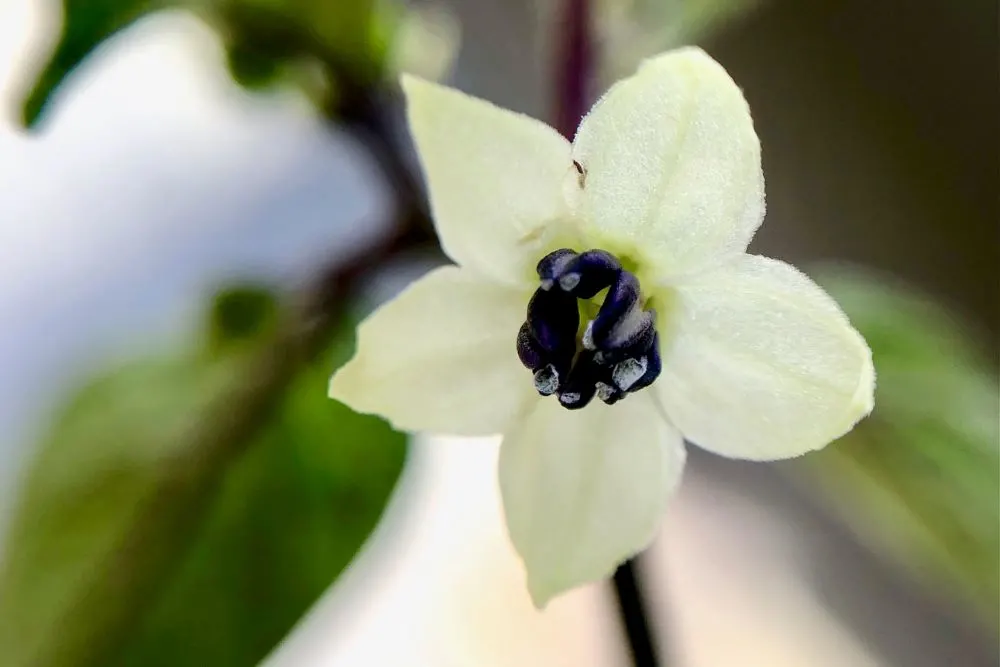
In order to produce peppers, a flower needs to be fertilized by compatible pollen. On pepper plants, each flower can produce pollen and take in pollen to become fertilized. Therefore, each flower can complete the process on its own.
Under normal conditions, a lone pepper plant will be perfectly happy to self-pollinate and produce fruits. A gust of wind, a buzzing bee visiting, or an ant wandering by will do the trick.
Since we are trying to cross pollinate, we need to prevent self-pollination. This requires a basic understanding of a flower’s anatomy.
Petals are the modified leaves that surround the reproductive organs of the flower. Collectively, they make up the flower’s corolla. These are typically white, yellow, green or purple on peppers.
The pistil is the flower’s female reproductive organ. It is the central tube on the flower, usually white in color. This tube is topped by the stigma, the opening that accepts a single grain of pollen to fertilize the flower’s ovary. Once this is complete, the flower can then begin to produce a fruit.
Anthers are the flower’s male reproductive organs, responsible for producing pollen. On peppers, they are typically white, yellow, orange or purple in color. They lie in the center of the flower surrounding the pistil. When mature, the anthers will begin producing powdery pollen.
Maternal and paternal plants. When crossbreeding, the maternal (mother) plant is the plant chosen to bear the fruit. The paternal (father) plant provides pollen to fertilize the flower of the maternal plant. In other words, the father plant pollinates a flower on the mother plant, resulting in a fruit.
Emasculation. In order to crossbreed peppers with confidence, we must ensure that the maternal plant does not self-pollinate. This involves carefully removing the male reproductive organs from the maternal plant’s flower.
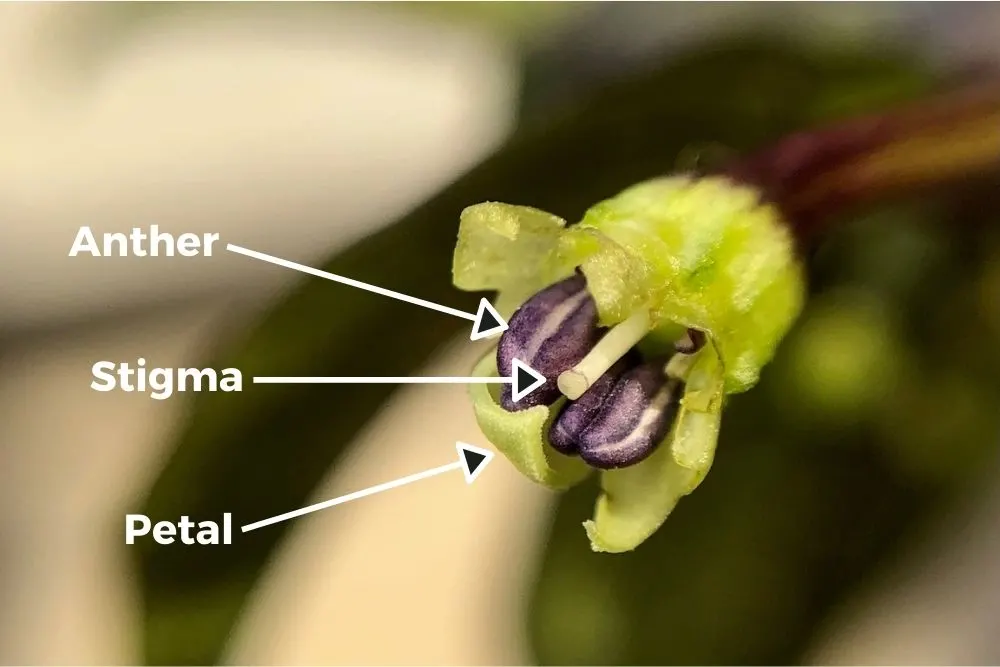
With these basic terms understood, we can now move on to the method of crossing two pepper varieties.
Choosing Which Peppers To Cross
First and foremost, you must choose two pepper varieties that are both stable and compatible with each other. Peppers from different species can sometimes be crossed, but it may be more difficult or even impossible in some cases.
Refer to this basic chart to understand which species are compatible for cross breeding.
Choosing Compatible Peppers
To keep things simple, I recommend crossing two pepper varieties within the same species. Much of the amateur breeding community focuses on the C. chinense species for the high heat and strange shapes and colors available.
Decide what traits you are trying to achieve by combining two varieties. Perhaps you’d like to keep the shape of one pepper, while adding the color of another. Or, maybe you want the high heat of one variety to complement the delicious flavor of another. Setting your goals at the start makes the long-term process much easier!
Once you have chosen two varieties, it is time to start planting.
Plant The Two Peppers
Since we will be isolating flowers, it is okay to plant your two varieties outdoors, right next to each other. In nature, the pollination process is imprecise, but we will be controlling the important parts.
If you want to speed up the process, you can try planting in smaller pots to encourage early fruiting. The drawback here is that smaller pepper plants tend to drop more flowers due to limited plant energy.
See our guide to planting peppers from seed here.
Paternal vs Maternal Plant
While your plants are growing, you may wonder which plant should be used as the father and which should be the mother. In other words, which plant will donate the pollen and which will bear the fruit?
Thankfully, this is a simple decision. I recommend cross breeding both ways. In other words, pollinate both plants with each other’s pollen. This way, the two resulting fruits can both be used to grow the next generation.
From the resulting plants, you can then determine which line of genetics you want to continue with.
How To Crossbreed Peppers
Once both of your plants begin to flower, you should be ready to perform the emasculation and pollination. For these instructions, I will refer to plant A and plant B to distinguish the two.
Note: Before beginning, ensure that both plants are ready. Plant A needs to have a flower that is about to open, while plant B must have an opened flower that is actively producing pollen.
Emasculation
Find a flower on plant A that is just about to open. How will you know? Try to research the variety you are growing to learn how large flowers are and when they typically bloom. Or, you can allow a few flowers to bloom to learn the plant’s pattern.
Once you have selected your flower on plant A, use tweezers or forceps to remove the petals and anthers from the flower. Be very careful not to disturb the pistil in the center, it is fragile and can easily be damaged!
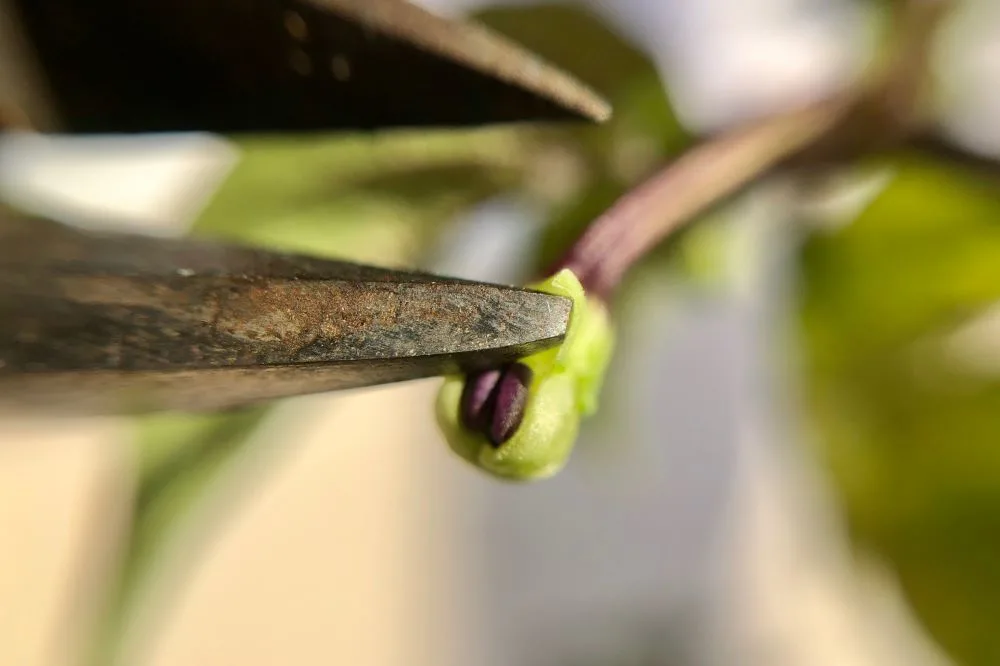
Once emasculation is complete, the flower should have nothing but the stem, calyx and pistil remaining. This is now your maternal flower, and it is ready to be fertilized by plant B’s pollen.
Pepper Cross Pollination
To collect pollen from plant B, use a dark-colored utensil (a plastic spoon or small sauce dish will work). Alternatively, you can use a small paintbrush or cotton swab.
Place the collection dish or spoon beneath the opened flower on plant B. Shake or flick the flower to release pollen into the dish. The first flick will release a majority of the flower’s pollen, so be sure not to miss it!
Carefully bring the collected pollen to the emasculated flower on plant A. Gently brush the pollen against the flower’s stigma (tip of the pistil), careful not to damage it.
Remember, just one pollen granule is required to fertilize the flower, so don’t be too aggressive. You can also repeat the pollination process for multiple days to ensure that the maternal flower is accepting pollen.
Flower Isolation
Once you have brushed pollen onto plant A’s stigma, the flower should be isolated from any surrounding flowers. It is crucial to avoid any other unwanted sources of pollen.
If the flower becomes exposed during the fertilization process, you can’t be sure of the cross. I use empty tea bags to gently cover the flower, sealing it away at the flower’s stem.
Check back on the flower every day for signs of fruit development. Once the flower is clearly beginning to become a fruit, the tea bag can be removed.
Labeling
While the flower is isolated and covered, it is easy to identify which has been crossed. However, once the flower begins to produce a fruit, it can be confused with other flowers.
For this reason, use a small piece of string to label and identify the flower later on. I recommend giving it a label with the specific cross that was performed (ex. Banana [P] x Jalapeño [M]).
Repeating The Cross in Reverse
I highly recommend repeating the process in reverse, where plant A provides pollen to fertilize an emasculated flower on plant B. Wait for a suitable day when both plants have suitable flowers.
After the flowers develop into fully-ripened pepper pods, they can be harvested to save the seeds. These seeds are the F1 (1st filial) generation of your pepper cross!
What If The Flowers Fall Off?
Unfortunately, all your hard work of emasculation and pollination can come to a quick end with the flower falling off. This can be upsetting, but there are things you can do to prepare for it.
If you can, cross pollinate several maternal flowers that are close to opening. This will give you some insurance against dropping flowers. You can also remove additional flowers that are near opening to avoid competing flowers on the maternal plant.
F1 Generation
The two resulting fruits should only be harvested when they are fully ripe. Save the seeds properly, and make sure that everything is properly labeled to avoid confusion.
If the two varieties that you have crossed are truly stable varieties (heirlooms, landraces, etc.), then your first generation (F1) plants should be very consistent.
Plant The Seeds
Keeping the different crosses separately labeled, plant the seeds to begin growing the first generation. The two plants should be nearly identical, given the genetic origins, but always plant both in case.
As the plants develop, you will begin to see what your new pepper cross will look like. I encourage you to take detailed notes on what you see.
Keep notes on these traits (and whatever else you care about):
- Germination time
- Growth rate
- Foliage color
- Time from planting to harvest
- Moisture tolerance
- Heat tolerance
- Budding rate (amount of flowers)
- Flower appearance (color, size, etc.)
- Fruit shape
- Fruit size
- Fruit color
- Yield
- Flavor
- Heat level
- Seed to harvest time
There are countless more minute characteristics that you may choose to monitor as your first generation is growing. Just be sure you keep a close eye on the things that matter most to you!
Isolation
As the F1 plants are flowering, you must keep the flowers isolated from other pepper varieties and pollen.
F1 pepper plants must self-pollinate.
If your F1 plants accidentally cross with another pepper variety, the resulting fruit and seeds will contain an unknown mash up of genetics. The original cross will then be lost, with uncertain genetics.
To keep your F1 plants isolated:
- Don’t plant other pepper varieties within 300 feet, or…
- Isolate the entire plants with cheesecloth or similar to avoid cross-pollination
- Isolate individual flowers before they open and until they begin to fruit
Choose Ideal Fruits and Save Seeds
When your F1 plants begin producing peppers, you should start to consider which peppers to save for the F2 (2nd filial) generation. Choose fruits that align with the original goal of your pepper cross.
Pick the fully ripened F1 peppers that you chose and save the seeds for planting F2.
F2 Generation
The 2nd generation is where things get very interesting.
The 2nd generation is when the plants will show the most variation.
Every individual seed that you saved from your F1 fruits contains a different genetic makeup. For this reason, I recommend planting as many seeds as you have room for, each in an individual seed cell.
Tip: If you are looking for specific foliage color, some F2 plants can be eliminated from the process early on. For example, if some seedlings have purple foliage and others have green, you may choose to terminate the green plants at this stage.
Once your F2 plants begin to flower, you should once again keep flowers isolated. The plants should be forced to self-pollinate to begin stabilizing genetics.
Choose Ideal Fruits and Save Seeds
Due to the extremely varied phenotypes of F2, choosing peppers to save can be more difficult than with the F1 stage. This is why setting your goals early on is so important.
If you have a clear goal in mind, you will have no trouble deciding which plants to save. If it is heat, taste test the pepper flesh and save seeds from the spiciest pod.
If it is color, save the pod that has the color you desire. If it is size, choose the largest or smallest pod. For yields, weigh the peppers from each plant to determine the most productive.
Once the seeds are saved, you now have your F3 seeds, and the cycle continues. For F3, the process repeats, planting as many seeds as possible, isolating plants, choosing ideal phenotypes, and saving seeds for the next generation of plants.
How Long Until a Pepper Variety is Stable?
After 7 or 8 generations of self-pollinated plants, a new pepper variety can be considered mostly stable. However, if unwanted pollen was introduced during any of the previous stages, the resulting seeds could contain unknown, unstable genetics.
If you take your time, growing just one generation per year, this process can take up to a decade. However, there are ways to speed things up if desired.
The easiest way to stabilize a variety faster is to plant indoors and use smaller pots. The smaller container size will force the plants to fruit more quickly.
When using smaller pots, the plants may only produce one fruit at a time. Therefore, it is crucial to attempt to pollinate as many flowers as possible. You can also remove excess flowers that have not been pollinated to avoid competition.
Conclusion
I have wanted to write this article for a long time. I am glad that I feel confident enough at this point to share my method.
Crossbreeding peppers properly is important for a number of reasons. In a world of amateur breeders rubbing flowers together and hoping for the best, much of the stable genetics are becoming confused. Unique seed varieties bought may not grow into the expected peppers, and saved seeds may be unstable.
New pepper varieties are given a name and sold with unstable genetics. Beautiful varieties emerge without proper documentation of origin. If we all work together to do things the right way, the catalogue of peppers will grow for all to enjoy.
I hope you enjoyed this guide on how to crossbreed peppers. If you have any questions, suggestions, or even cross examples you’d like to share, please reach out to us at [email protected].
Thanks!


pepper nerd
Wednesday 6th of December 2023
How do you know if a hybrid pepper is unstable?
peppergeek
Monday 11th of December 2023
Any new hybrid will be unstable. F2 is the most unstable stage. So if you saved seeds from an F1 hybrid, you'll be growing out F2. This is why I never recommend saving seeds from hybrid plants
Greg
Monday 13th of November 2023
It would be great for PDF to be in actual A4 size friendly for ISO full size printing rather than not standardised ratio. Thanks for your efforts, very interesting article.
peppergeek
Monday 13th of November 2023
Thanks for the feedback - I will look into this and make an adjustment
Michael
Thursday 28th of September 2023
I planted various peppers within close proximity. I planted White Reapers very close to Snow whites and 1 of the reaper plants (mother plant) is producing peppers that look like a hybrid. Same thing with 2 other plants, purple jalapeno and carolina cayenne. The mother plant is producing peppers that look like a combo of both. Is this possible? If not, what is causing these variations?
Brock Conahue
Monday 3rd of April 2023
This article was HOT!
David Runte
Friday 23rd of September 2022
My son planted some Jalapeno Peppers in between two tomato plants and now the peppers are not even spicy. I told him the tomatoes cross pollinated the pepper and now they taste like Bell Peppers. Is this possible?
peppergeek
Friday 23rd of September 2022
No this definitely isn't the cause. Crossing only affects the next generation of plants, so saved seeds from this year could be crosses. Tomatoes cannot cross with peppers either, so it'd have to be another pepper plant.